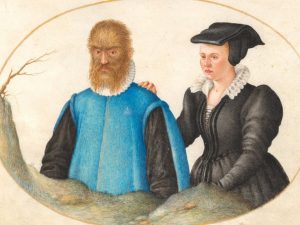- admin
- Nov, 06, 2024
- Curiosity
- Commenti disabilitati su Beauty and the Beast: A Family of “Hairy Wildlings” at the Farnese Court

In the tranquil castle of Capodimonte, known as “La Rocca” and nestled on the serene shores of a lake, the peculiar story of Pedro González came to an end during the years of the Farnese dynasty. But who was he? Pedro was a Spanish noble, born in 1537 on Tenerife, a newly conquered island in the Canary Archipelago. At the age of ten, like many indigenous people resisting Spanish rule, Pedro was captured and enslaved. Eventually, he found himself in the hands of French corsairs, who presented him as an “exotic treasure” to celebrate the marriage of King Henry II of France to Catherine de’ Medici.
Upon seeing this young boy, covered in thick hair reaching nearly four inches in length, the French king thought he was gazing upon a creature half-man, half-beast. But in reality, Pedro suffered from hypertrichosis, a rare genetic condition that causes excessive hair growth, giving an almost animal-like appearance. Rather than reject him, the king took Pedro into his court, seeing it as a challenge to “civilize” this strange “wild child.”
Pedro, who proved to be intelligent and quick-witted, soon mastered French, Italian, the humanities, and even Latin, astonishing the nobles of Europe. Nicknamed the “sauvage du Roi” (the King’s wild man), he was even granted the title of “Don,” though at court he was often affectionately called “Barbet” due to his resemblance to the king’s beloved dog. Pedro inspired not pity or revulsion but curiosity and admiration, with many aristocrats competing for his company, treating him as a rare and exotic gem of the court.
In her own particular way, Catherine de’ Medici took a keen interest in Pedro’s future. For reasons of curiosity, entertainment, or perhaps something darker, she decided he should be wed and found him a bride in her beautiful young lady-in-waiting, Catherine Raffelin. Though the poor girl reportedly fainted upon seeing her husband for the first time, their marriage unexpectedly blossomed into a happy union. Together, Don Petrus Gonsalvus (as he was now known) and Catherine had seven children, five of whom inherited their father’s condition. Their portraits, featuring Pedro’s signature “wild look” refined by the elegance of a gentleman, soon became sought-after curiosities across European courts.
Pedro served at the French court for forty-four years as “sommelier de panneterie bouche,” a prestigious role assisting with royal dining, but in 1580, he left for the court of Margaret of Austria, Duchess of Parma. A few years later, after Margaret’s death, the González family moved to Parma, to the court of Ranuccio Farnese. Though they were honored guests, Pedro struggled with the lack of purpose in his new role, feeling like a mere curiosity. After a brief post as estate manager for the Farnese lands in Collecchio, he eventually moved his family to Capodimonte, where he spent his final years as the wardrobe manager for the Farnese family.
Pedro passed away quietly in 1618 at the age of eighty, far from the notoriety that had once defined his life. His wife Catherine died in Capodimonte seven years later. Parish records detail the family’s various milestones, including births, marriages, and other events involving the González descendants, known affectionately by the locals as “the Hairy Ones.”
Pedro’s son Henri, Italianized as Arrigo, became a protégé of Cardinal Odoardo Farnese and took up the unusual sideline of village moneylending, supplementing his income with small loans and less-than-legal dealings. He even found a place in art history as the subject of Agostino Carracci’s famous painting “Arrigo peloso, Pietro Matto, Amon Nano et altre bestie”, now housed in Naples. The other González children gradually faded into history, leaving little trace of their lives and legacies.
The story of Pedro and Catherine has long fascinated people, giving rise to the enduring tale of “Beauty and the Beast”, a legend that began circulating in Europe in the late sixteenth century. Though likely inspired by the real-life figure of Gonsalvus, “Beauty and the Beast” finds its roots in the ancient Greek and Roman tales of transformation, notably in “Metamorphoses” by Apuleius, where a beautiful young woman is forced to marry a creature only to discover he is, in truth, a refined prince. Recently, Pedro’s story was recounted in the 2013 documentary film “Gonsalvus – Die wahre Geschichte von Die Schöne und Das Biest”, directed by Julian Roman Pölsler and filmed in part in Capodimonte.